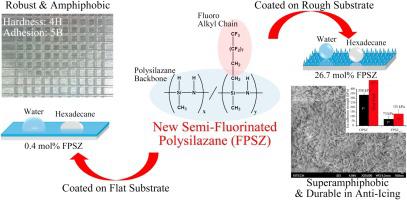当前位置:
X-MOL 学术
›
Prog. Org. Coat.
›
论文详情
Our official English website, www.x-mol.net, welcomes your feedback! (Note: you will need to create a separate account there.)
Synthesis of new semi-fluorinated polysilazanes and their amphiphobic coating applications
Progress in Organic Coatings ( IF 6.6 ) Pub Date : 2020-11-01 , DOI: 10.1016/j.porgcoat.2020.105853 Tien N.H. Lo , Ha Soo Hwang , Jiyoung Lee , In Park
Progress in Organic Coatings ( IF 6.6 ) Pub Date : 2020-11-01 , DOI: 10.1016/j.porgcoat.2020.105853 Tien N.H. Lo , Ha Soo Hwang , Jiyoung Lee , In Park

|
Abstract A series of new semi-fluorinated polysilazanes (FPSZs) were prepared via ammonolysis of dichloro(1H,1H,2H,2H-perfluorodecyl)methylsilane (DCFMS) and dichloromethylsilane. The FPSZs consist of methylsilazane and fluorinated silazane moieties, which provide excellent adhesion to substrates and a low surface energy, respectively. FPSZs with various DCFMS ratios (0.2–100 mol%) were obtained with a facile control over the fluorinated composition by adjusting the precursor ratio. The water and oil contact angles increased as a function of DCFMS loading and saturated at values of 112° and 54°, respectively, for just 0.4 mol% of DCFMS coated on flat Al substrates. To obtain superamphiphobicity, a hierarchical nano-micro rough surface for the Al plates is required for which they were etched with HCl and then immersed in boiling water. The FPSZ containing 26.7 mol% (FPSZ26.7) of fluorinated moiety exhibited a water contact angle of 173° and an oil contact angle of 148° when it was coated on the rough Al substrate. The water contact angle of the rough Al plate coated with a non-fluorinated organic polysilazane (OPSZ) was also higher than 160°, but the measurement of ice adhesion force failed after 40 icing/melting cycles (338 kPa before icing) owing to physical damage to the surface in the icing/melting process. However, the rough Al plate coated with FPSZ26.7 exhibited improved anti-icing properties—the ice adhesion strength was 131 kPa after the 40 icing/melting cycles (73 kPa before the icing tests).
中文翻译:

新型半氟化聚硅氮烷的合成及其两性涂层应用
摘要 通过二氯(1H,1H,2H,2H-全氟癸基)甲基硅烷(DCFMS)和二氯甲基硅烷的氨解反应制备了一系列新型半氟化聚硅氮烷(FPSZs)。FPSZ 由甲基硅氮烷和氟化硅氮烷部分组成,它们分别提供对基材的优异附着力和低表面能。通过调节前体比例,可以轻松控制氟化组合物,从而获得具有各种 DCFMS 比例(0.2-100 mol%)的 FPSZ。水和油的接触角随着 DCFMS 负载的增加而增加,并且分别在 112° 和 54° 的值下饱和,仅 0.4 mol% 的 DCFMS 涂覆在平面铝基板上。为了获得超疏水性,Al 板需要一个分级的纳米微米粗糙表面,用 HCl 蚀刻它们,然后浸入沸水中。含 26.7 mol% (FPSZ26.7) 氟化部分的 FPSZ 在涂覆在粗糙的铝基板上时表现出 173° 的水接触角和 148° 的油接触角。涂有非氟化有机聚硅氮烷 (OPSZ) 的粗糙铝板的水接触角也高于 160°,但在 40 次结冰/融化循环(结冰前 338 kPa)后,由于物理原因,冰粘附力的测量失败。在结冰/融化过程中损坏表面。然而,涂有 FPSZ26.7 的粗糙铝板表现出改善的防冰性能——在 40 次结冰/融化循环后冰粘附强度为 131 kPa(结冰测试前为 73 kPa)。涂有非氟化有机聚硅氮烷 (OPSZ) 的粗糙铝板的水接触角也高于 160°,但在 40 次结冰/融化循环(结冰前 338 kPa)后,由于物理原因,冰粘附力的测量失败。在结冰/融化过程中损坏表面。然而,涂有 FPSZ26.7 的粗糙铝板表现出改善的防冰性能——在 40 次结冰/融化循环后冰粘附强度为 131 kPa(结冰测试前为 73 kPa)。涂有非氟化有机聚硅氮烷 (OPSZ) 的粗糙铝板的水接触角也高于 160°,但在 40 次结冰/融化循环(结冰前 338 kPa)后,由于物理原因,冰粘附力的测量失败。在结冰/融化过程中损坏表面。然而,涂有 FPSZ26.7 的粗糙铝板表现出改善的防冰性能——在 40 次结冰/融化循环后冰粘附强度为 131 kPa(结冰测试前为 73 kPa)。
更新日期:2020-11-01
中文翻译:

新型半氟化聚硅氮烷的合成及其两性涂层应用
摘要 通过二氯(1H,1H,2H,2H-全氟癸基)甲基硅烷(DCFMS)和二氯甲基硅烷的氨解反应制备了一系列新型半氟化聚硅氮烷(FPSZs)。FPSZ 由甲基硅氮烷和氟化硅氮烷部分组成,它们分别提供对基材的优异附着力和低表面能。通过调节前体比例,可以轻松控制氟化组合物,从而获得具有各种 DCFMS 比例(0.2-100 mol%)的 FPSZ。水和油的接触角随着 DCFMS 负载的增加而增加,并且分别在 112° 和 54° 的值下饱和,仅 0.4 mol% 的 DCFMS 涂覆在平面铝基板上。为了获得超疏水性,Al 板需要一个分级的纳米微米粗糙表面,用 HCl 蚀刻它们,然后浸入沸水中。含 26.7 mol% (FPSZ26.7) 氟化部分的 FPSZ 在涂覆在粗糙的铝基板上时表现出 173° 的水接触角和 148° 的油接触角。涂有非氟化有机聚硅氮烷 (OPSZ) 的粗糙铝板的水接触角也高于 160°,但在 40 次结冰/融化循环(结冰前 338 kPa)后,由于物理原因,冰粘附力的测量失败。在结冰/融化过程中损坏表面。然而,涂有 FPSZ26.7 的粗糙铝板表现出改善的防冰性能——在 40 次结冰/融化循环后冰粘附强度为 131 kPa(结冰测试前为 73 kPa)。涂有非氟化有机聚硅氮烷 (OPSZ) 的粗糙铝板的水接触角也高于 160°,但在 40 次结冰/融化循环(结冰前 338 kPa)后,由于物理原因,冰粘附力的测量失败。在结冰/融化过程中损坏表面。然而,涂有 FPSZ26.7 的粗糙铝板表现出改善的防冰性能——在 40 次结冰/融化循环后冰粘附强度为 131 kPa(结冰测试前为 73 kPa)。涂有非氟化有机聚硅氮烷 (OPSZ) 的粗糙铝板的水接触角也高于 160°,但在 40 次结冰/融化循环(结冰前 338 kPa)后,由于物理原因,冰粘附力的测量失败。在结冰/融化过程中损坏表面。然而,涂有 FPSZ26.7 的粗糙铝板表现出改善的防冰性能——在 40 次结冰/融化循环后冰粘附强度为 131 kPa(结冰测试前为 73 kPa)。



























 京公网安备 11010802027423号
京公网安备 11010802027423号